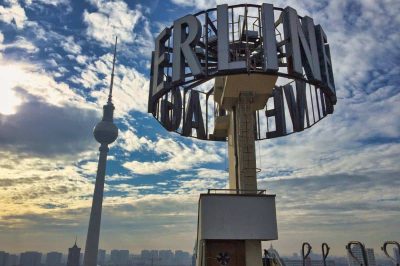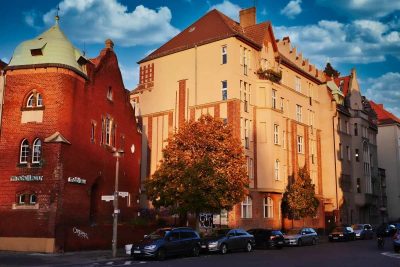Berlin is one of the most dynamic metropolises in the world and has undergone a breathtaking transformation in recent years. This is true not only for the West, but especially for the East of the city, the former capital of the GDR. Since we at Wild East are focused on the East, we naturally present only the most beautiful East Berlin sights in keeping with the style. In addition to the many historic sites, some new ones have been added in the years since German reunification. Today we want to introduce you to the most important old and new sights to see in Berlin and take you on a trip to the capital. If you are interested in practical information about Berlin, you can find important tips for your trip here.
These are the top 15 Sights to see in Berlin
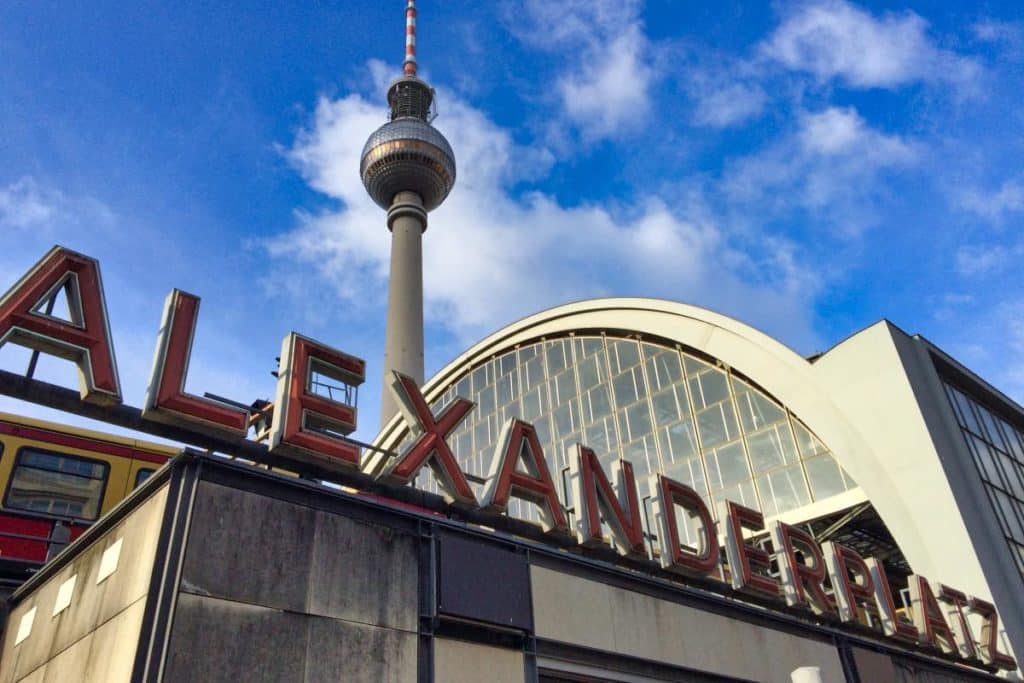
Alexanderplatz with TV tower
The “Alex” is one of the busiest squares in Berlin. Alfred Döblin set a literary monument to the former parade ground in 1929 with his book “Berlin Alexanderplatz,” capturing the feeling of life in Berlin in the 1920s like perhaps no other book. At the time, cabarets and modern department stores dominated the scene and attracted people from all over Germany. During World War II, the square and surrounding buildings were heavily destroyed.

World time clock and central square with hooker brooch
After the war, the GDR government decided to redesign the square on a large scale. A Centrum department store was built, but also the Fountain of Friendship between Peoples, known by Berliners as “Nuttenbrosche,” (“Hookers Brooch”) and the famous World Time Clock, today one of the city’s most popular meeting places. The Teacher’s House with its huge frieze showing various everyday scenes of GDR citizens also dates from that time. As you can see, there is a lot going on at the “Alex”!
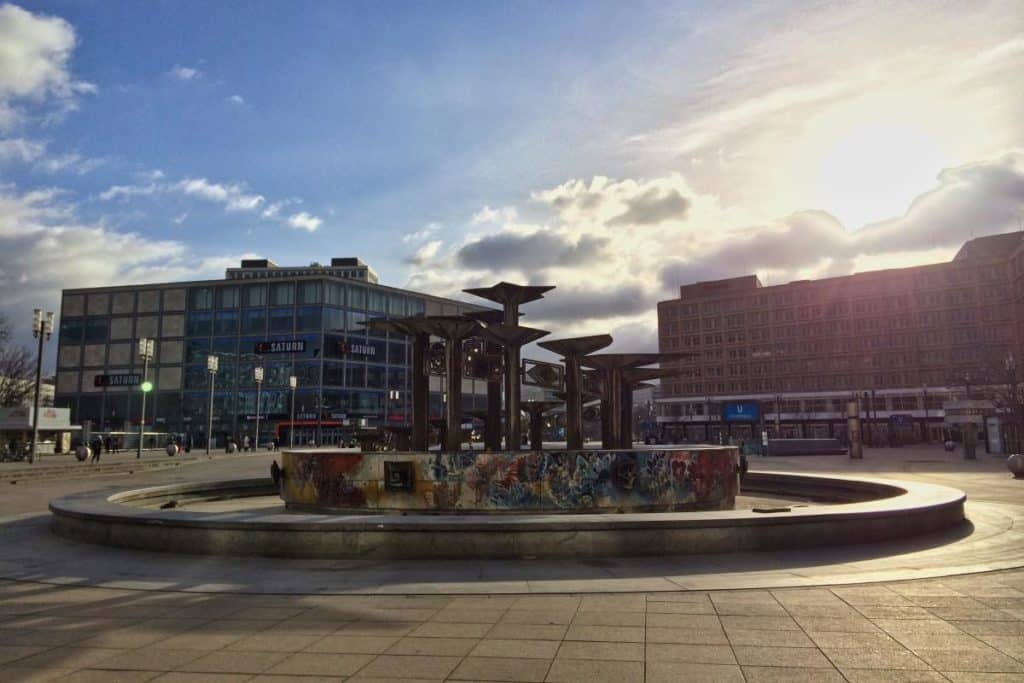
Berlin TV Tower
The absolute eye-catcher, however, is the TV tower, which officially no longer belongs to the “Alex”. The “Telespargel” (“Television Asparagus”) is the highest building in the city. In the restaurant at a height of 200 meters you have the best view of the capital and do not even have to move for the panoramic view, because the restaurant circles around within 30 minutes! One floor below you can also enjoy a fabulous view of Berlin from the viewing gallery.
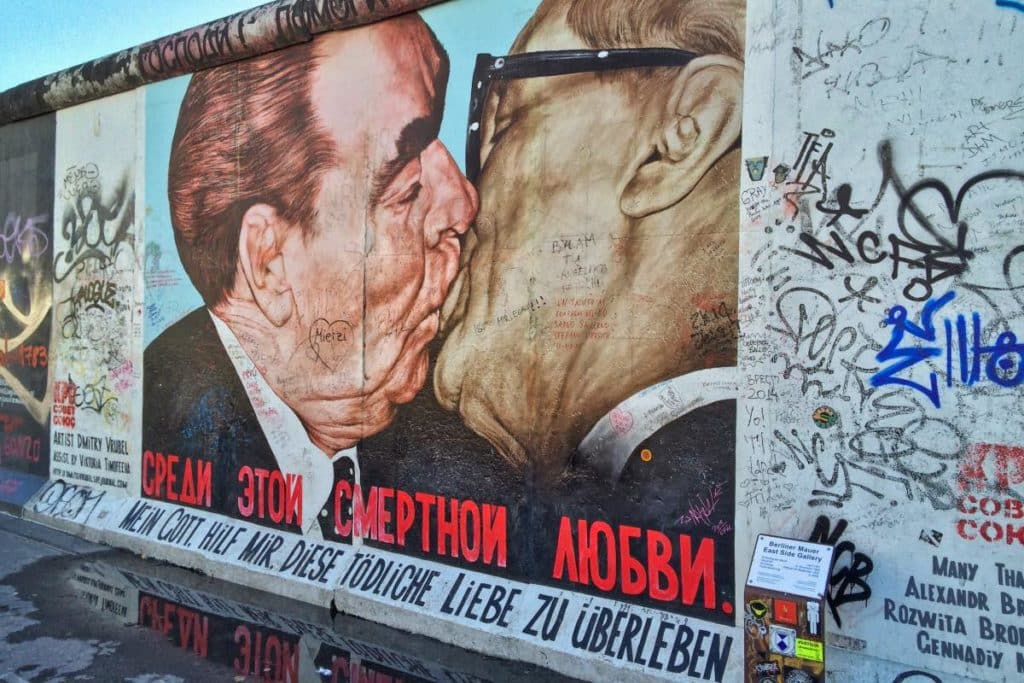
East Side Gallery
Not much is left of the Wall in Berlin – fortunately. The East Side Wall between Ostbahnhof and Oberbaumbrücke used to shield parts of Friedrichshain from neighboring Kreuzberg. In the spring of 1990, parts of the Wall were torn down.
At the East Side Gallery, it was decided to invite artists and let them create something to mark this historic event. 118 artists from 21 countries came. The result was what is now the largest open-air gallery in the world. Some of the artworks today stand iconically not only for the East Side Gallery, but as advertisements for the city of Berlin. Among the most famous and beautiful works are Dmitri Wrubel’s “My God, Help Me Survive This Fatal Love,” featuring the brotherly kiss of Honecker and Brezhnev, and Birgit Kinder’s “Test the Best.”
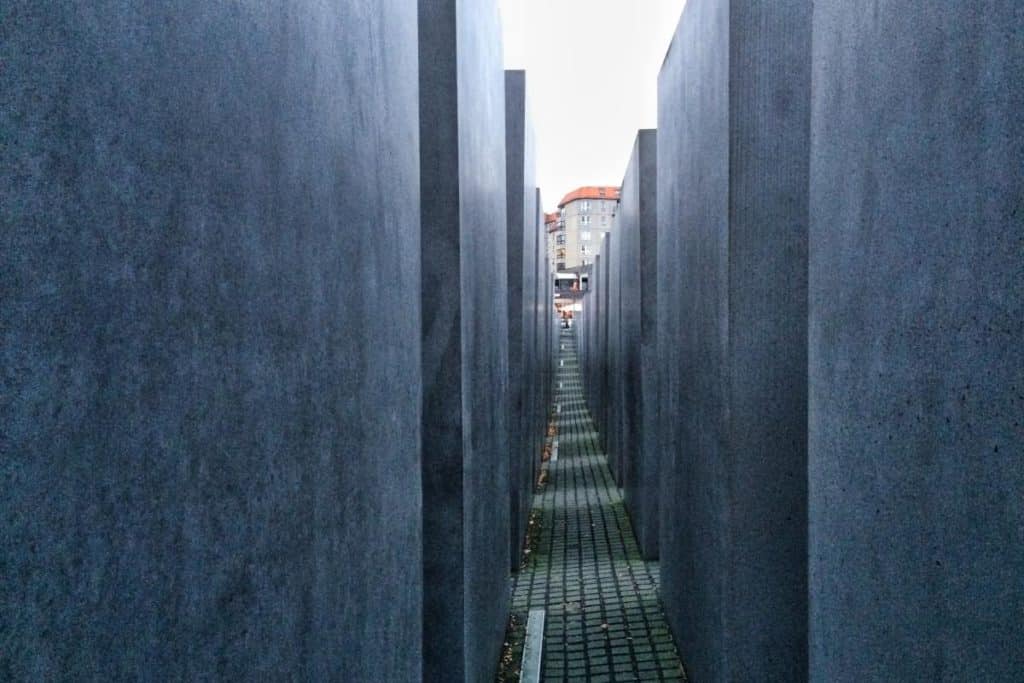
Holocaust Memorial
The Memorial to the Murdered Jews of Europe has been commemorating the Jews killed by the Germans in the Holocaust since 2005. Until 1989, the area had served as part of the Berlin Wall. But since a central memorial was to commemorate the Shoah, the area not far from the Brandenburg Gate was chosen for it. There are now a total of 2711 concrete steles here of varying heights. Walking through them, one gets the feeling of walking into a labyrinth and almost being crushed by the cold concrete steles. The monument is one of the most impressive memorials and its composition is truly unique. Visiting this place is free of charge and there is also an exhibition under the memorial.
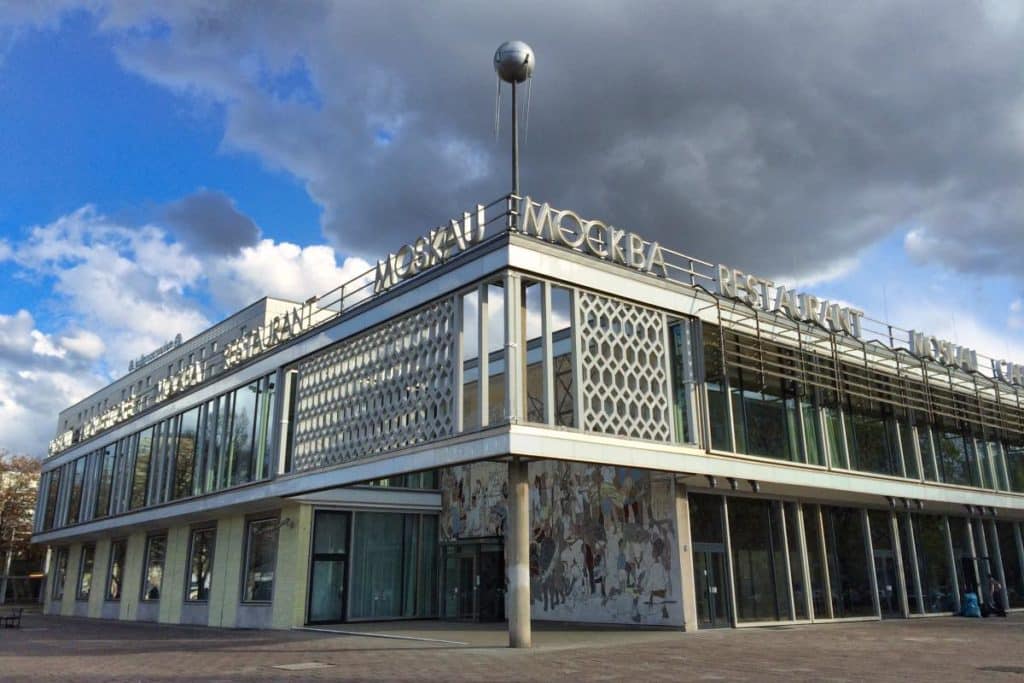
Karl-Marx-Allee
Built as Stalinallee in the early 1950s, today’s Karl-Marx-Allee is the largest continuous ensemble of buildings of socialist architecture in Berlin. This showcase street was meant to display the most modern and best buildings of the GDR. And indeed, it is a microcosm of GDR architecture. For even though the street was originally built in the style of Stalinist neoclassicism, there are also very functional and modern-looking buildings to be seen here. Among the most beautiful are Café Moskau, Kino International and Kino Kosmos, as well as the buildings around Strausberger Platz. Along the street there are many information boards that inform about the history and architecture.
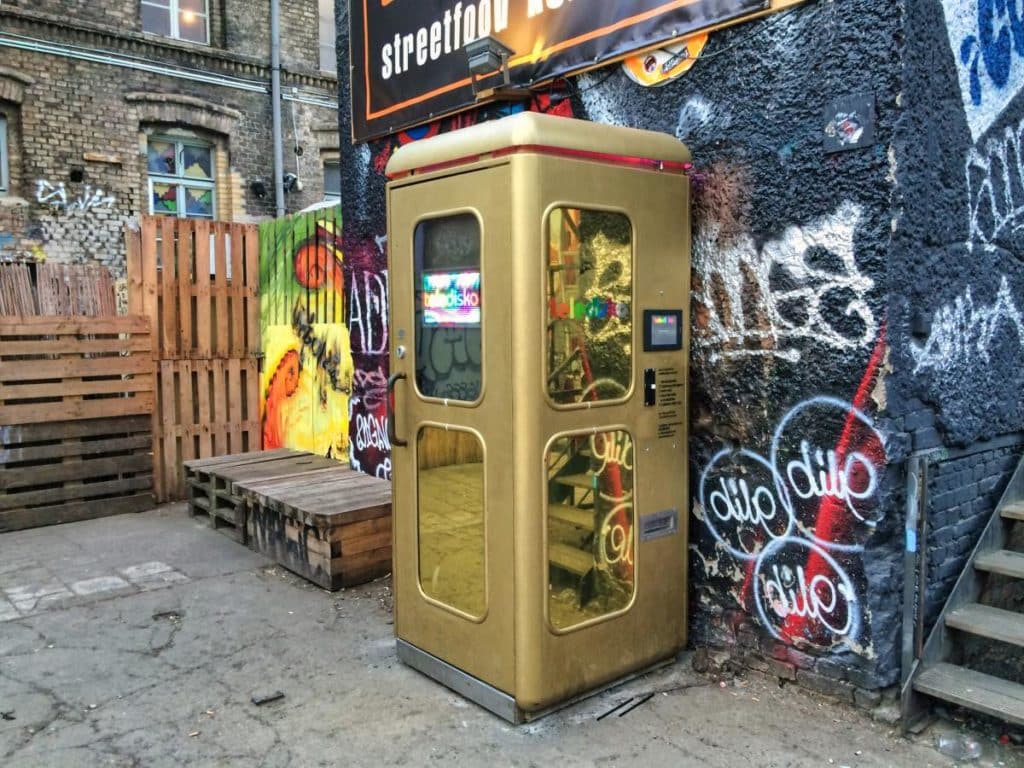
RAW area
The RAW site is located not far from the East Side Gallery and the Warschauer Straße S-Bahn and U-Bahn station in Friedrichshain. The former Reichsbahn repair works is now the largest cultural area in the city. There are countless bars and clubs here. Even a skate hall, a climbing tower and a swimming pool can be found here. On weekends, when Corona is not spoiling your fun, thousands of people pass through here. Food stalls feed the hungry mob. Flea markets are held frequently. Many buildings were designed by artists or are painted with graffiti.
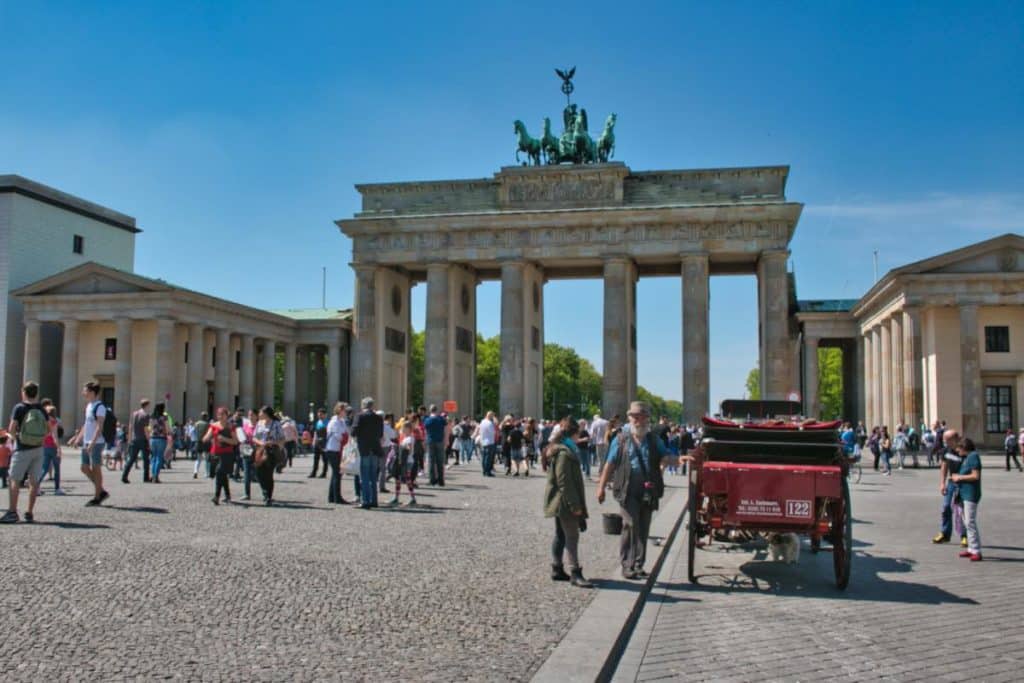
Brandenburg Gate
Like hardly any other building, the Brandenburg Gate is so closely associated with German division and reunification. It stands at the end of East Berlin’s boulevard Unter den Linden and was built at the end of the 18th century in the style of classicism. The Quadriga, a bronze figure depicting Victoria, the goddess of victory, and her team of four horses, crowns the gate and is one of the city’s most popular photo motifs. This area of Berlin was also heavily destroyed during the war.
The rulers had only the Brandenburg Gate rebuilt. From 1961, the Berlin Wall ran directly behind the gate, making the Brandenburg Gate a symbol of the divided city. This tourist hotspot of Berlin should not be missing on our list of the most important sights to see in Berlin’s East.
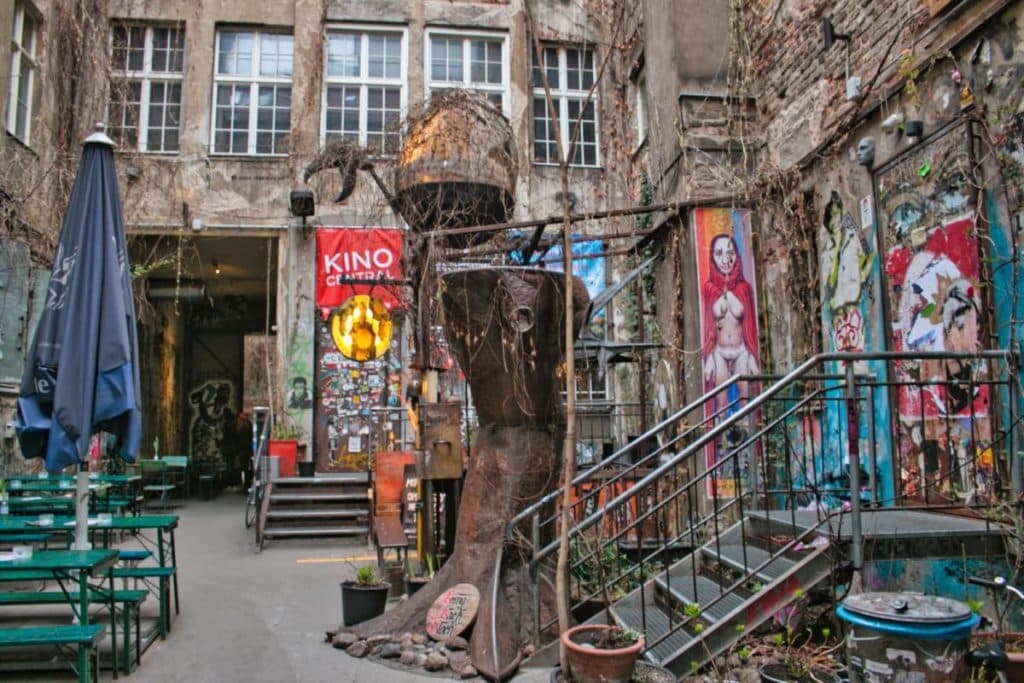
Hackesche Höfe and Haus Schwarzenberg
At the beginning of the 20th century, several residential quarters were built west of Alexanderplatz. So far, so ordinary. But the Hackesche Höfe pursued a revolutionary concept: Germany’s largest residential and commercial courtyard complex at the time was planned for workers. They were not to be merely colorless tenements, but had heating and indoor toilets. They were also surrounded by green spaces, allowing a comfortable living on a budget. In 1997, the Hackesche Höfe were extensively renovated and have since been restored to their former glory. Today you can spend hours in the many restaurants, galleries and artists’ studios and then marvel at the impressive colorful facades. Next door is the Schwarzenberg House with a lot of street art.
Museum Island
A kind of “city within the city”, picturesquely surrounded by the Spree and Spree Canal, is located in the heart of the former capital of the GDR. Here you can find the most important museums in Germany. No matter what kind of art you are interested in, you will definitely not get bored here! There is so much to see here that you can probably only visit two museums in one day, but you could also easily spend days in just one of the houses. And if you want to relax, you can do so in the Lustgarten, which was originally designed by Peter Joseph Lenné and is now used by countless couples as a seating area in the summer.
Old Museum
The Old Museum (Altes Museum) was one of the first public museums in the country and has been delighting its visitors since 1830. Here you can see numerous ancient works of art, sculptures, vases and much more. Architecturally, the Old Museum also knows how to convince. The legendary Prussian master builder Karl Friedrich Schinkel was responsible for its construction. “There’s a Schinkel in every corner” is what people like to say about Berlin. The Altes Museum, with its portico perfectly echoing the ancient museum theme, is definitely one of the most beautiful of them all.
New Museum
Where there is an Old Museum, there must of course also be a New Museum (Neues Museum). It was opened ten years after the Old Museum and was heavily destroyed during the Second World War. Restoration began shortly before the fall of the Berlin Wall, and the New Museum was officially opened in 2009. It is not modern art that is exhibited here, but the museum is home to the world-famous bust of Nefertiti. The mysterious beauty is one of the most important museum exhibits in Germany. In addition, you will find numerous other exhibits from ancient Egypt.
Pergamon Museum
You haven’t had enough of the ancient world yet? Then go to the Pergamon Museum. It was only built in the 20th century and shows Middle Eastern and Islamic art. The star of the exhibition is the famous Pergamon Altar, to which the museum owes its name. It was designed around 170 BC in what is now Turkey, and its detailed friezes are still in remarkable condition. To keep it that way, the altar will be restored until 2024. Until then, you can view a 3D model of the altar here.
Bode Museum
The Bode Museum, a historicist building, has captured the most beautiful spot on Museum Island. It stands on the northern tip of the island and can thus be seen from afar. Here you can admire the largest collection of sculptures in Europe, but you will also find many other works of art, mainly from the years 800 to 1800. The attached coin collection and the Byzantine Museum are also worth a visit.
Old National Gallery
The Alte Nationalgalerie (Old National Gallery) marks the end of our excursion to Museum Island. Just like the New Museum, the National Gallery was designed by Friedrich August Stüler, a student of Schinkel. The Alte Nationalgalerie reminds me a bit of an ancient temple and indeed it is a real temple of art, where you can marvel at countless paintings from the 19th and early 20th century.
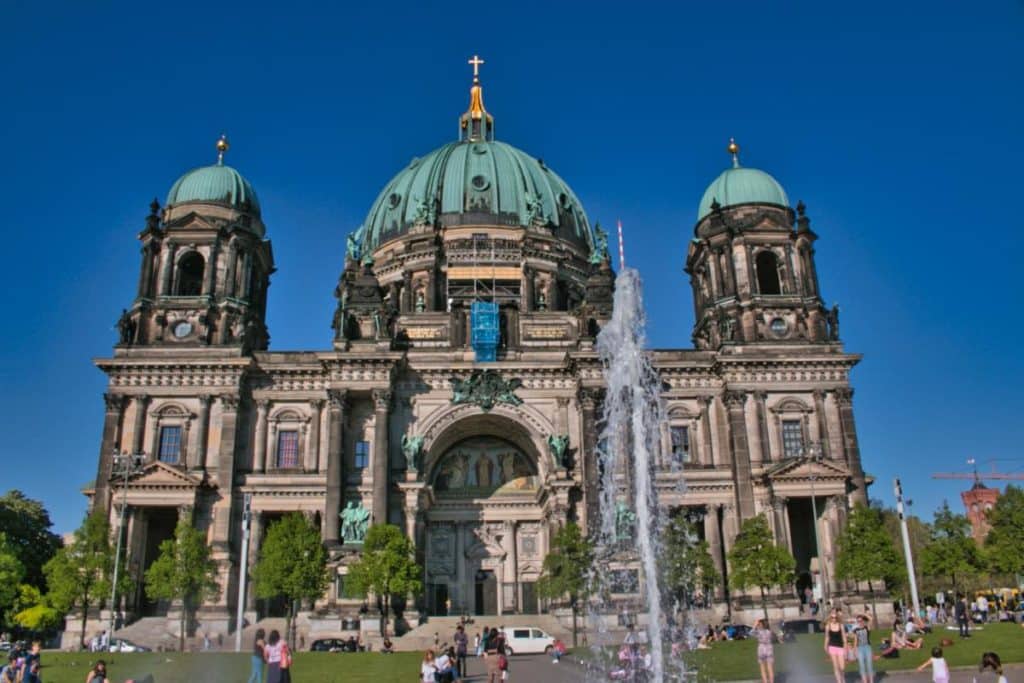
Berlin Cathedral
The monumental Berlin Cathedral made of granite and sandstone is one of the largest Protestant churches in Germany. At the beginning of the 20th century, the house of worship was built at the behest of the emperor, this time Schinkel and Stüler were allowed to lend a hand together. Here you can admire not only the largest organ in Germany, but also those of some important representatives of the Hohenzollern family, because the church was built as the central burial place of the ruling dynasty, which provided not only the Prussian kings, but from 1871 also the German emperors.
Over a hundred coffins can be found here in the underground of the church. Our tip: Here you can download a free audio guide to the church. And if you don’t have time to visit the church, you can at least take a virtual tour there.
Gardens of the World
The Berlin district of Marzahn-Hellersdorf is not exactly an area that would attract a particularly large number of tourists. To mark the 750th anniversary of the city, a park was opened here that functioned under the name Berliner Gartenschau. But the biggest boost to the nearly 100-hectare site came when Berlin won the bid to host the 2017 International Garden Show, which was a huge success. The name Gardens of the World says it all. You can stroll through Chinese, Japanese, Balinese, Oriental and Korean garden landscapes here and enjoy the tranquility and beauty of the manicured grounds. Or you can take a ride on the cable car to the Kienberg. Yes, you heard me right, this is also possible in East Berlin.
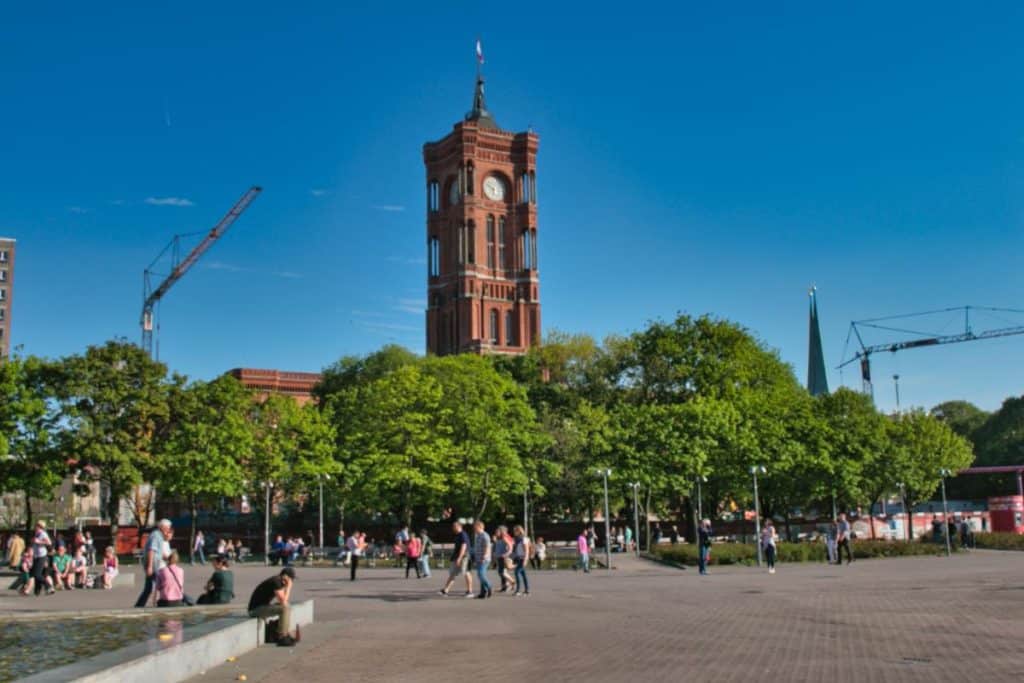
Rotes Rathaus
Rotes Rathaus (“Red City Hall”) is the seat of Berlin’s ruling mayor and was designed precisely for this purpose shortly before the founding of the Reich, coincidentally on the site where Berlin’s city hall already stood in the Middle Ages, as was discovered a few years ago during the construction of the U5 extension. The name refers not to the fact that the GDR bigwigs once guided the city’s fortunes here, but to the red brick facade. The Second World War also brought severe destruction here, but the reconstruction was closely oriented to the original building. Since it is a public building, you can stroll through the magnificent halls of the town hall today without being disturbed, and you don’t even have to pay an entrance fee.
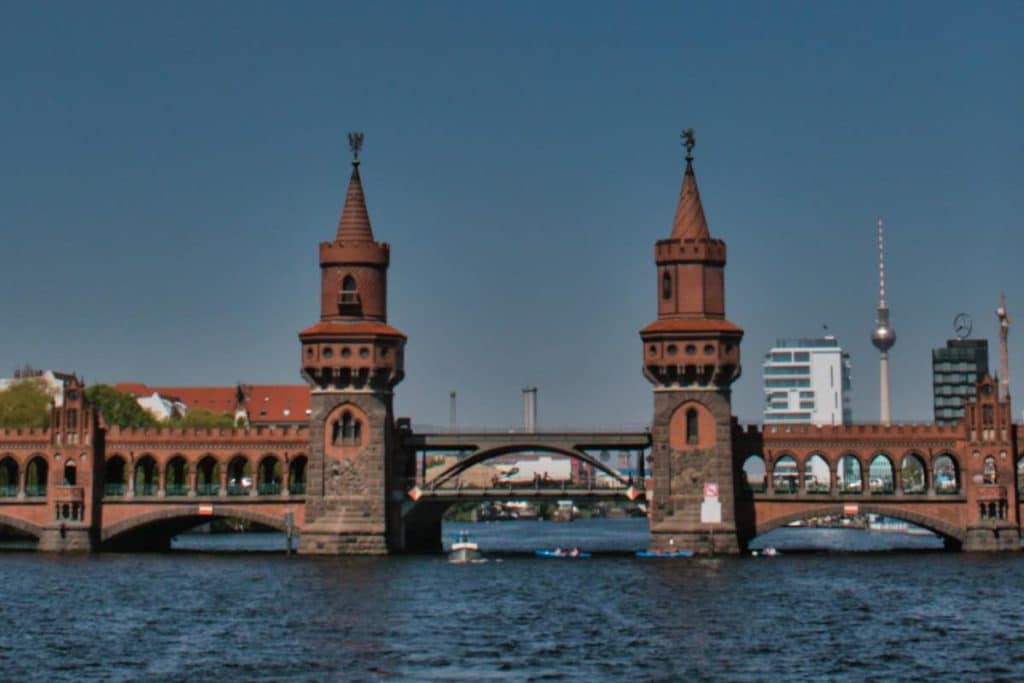
Oberbaum Bridge
Speaking of beautiful red buildings: The Oberbaum Bridge is also a popular photo object and connects the south with the north bank of the Spree not far from the East Side Gallery. At the end of the 19th century, under the then Berlin building council Otto Stahn, the building, executed by the Siemens company, was erected in the neo-Gothic style, bringing a little medieval flair to this modern part of the city. In 1902, the first Berlin subway (today’s U1) was already running here on the bridge. You can explore the Oberbaumbrücke quite comfortably by strolling through the arcade, which looks like a medieval cloister.
Müggel Tower
Had enough of the hustle and bustle of the capital? The Berlin district of Köpenick is still part of Berlin, but seems more like a small town. It is Here you will find an observation tower built in the early 1960s on the edge of Müggelsee. Here on the Müggelberg there was already a tower from 1880, but it burned down during renovation works in the 1950s.
A new tower was needed and the result can still be seen today. Designed by students and financed by the people of Berlin, among others, a building was created that was not oriented towards the Socialist Realism style that had prevailed until then, but in a sense represented Berlin’s departure into modernity. The chic reinforced concrete building with its wide window fronts still offers a great view over the Müggelsee, the Müggelberge and the Langer See. Currently, another tower is planned to be connected with the old Müggel Tower.
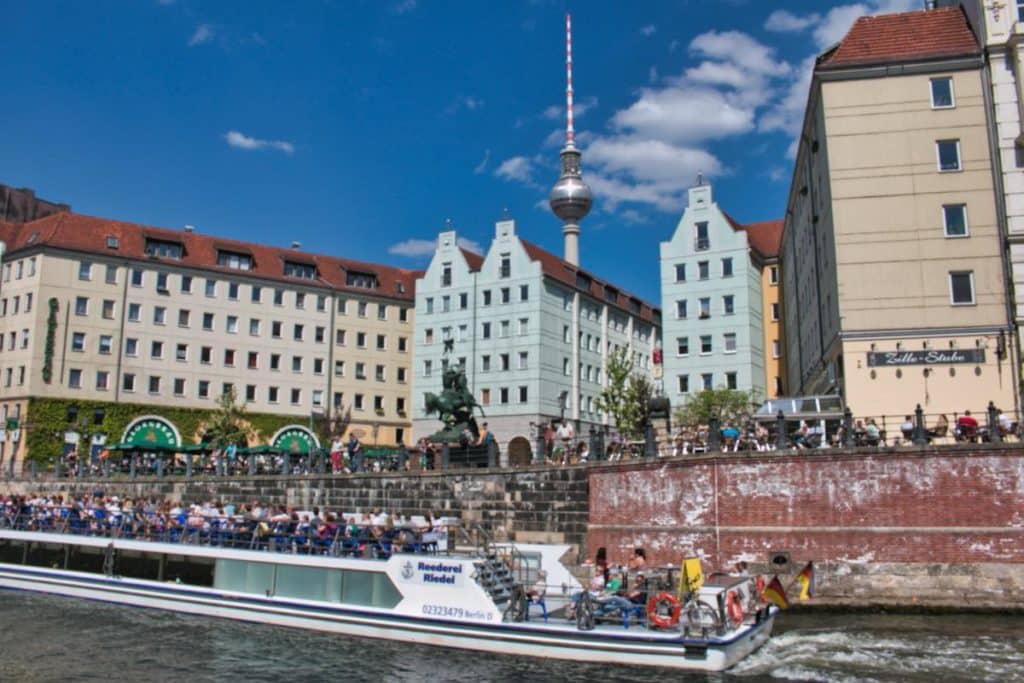
Nikolaiviertel
This is literally where it all began: the Nikolai Quarter (Nikolaiviertel) in the Mitte district was the historic first part of Berlin to be settled. The quarter was almost completely bombed out during the Second World War. For a long time, it was difficult to develop a stringent development plan for this part of the city, but just in time for the 750th city anniversary in 1987, the time had come. The historic buildings Ephraim-Palais and Knoblauchhaus were joined by several prefabricated buildings that recall the historic heritage of this place and create a mix of styles that is as peculiar as it is worth seeing.
In the center of the quarter stands the Nikolaikirche, which you can’t tell that it only dates back to the 1980s in this form and which builds a structural bridge between the church from the 13th century that once stood here and its rebuildings in the 19th century. The quarter is therefore something for architecture fans and explorers and must not be missing from our list of the most important sights to see in Berlin.
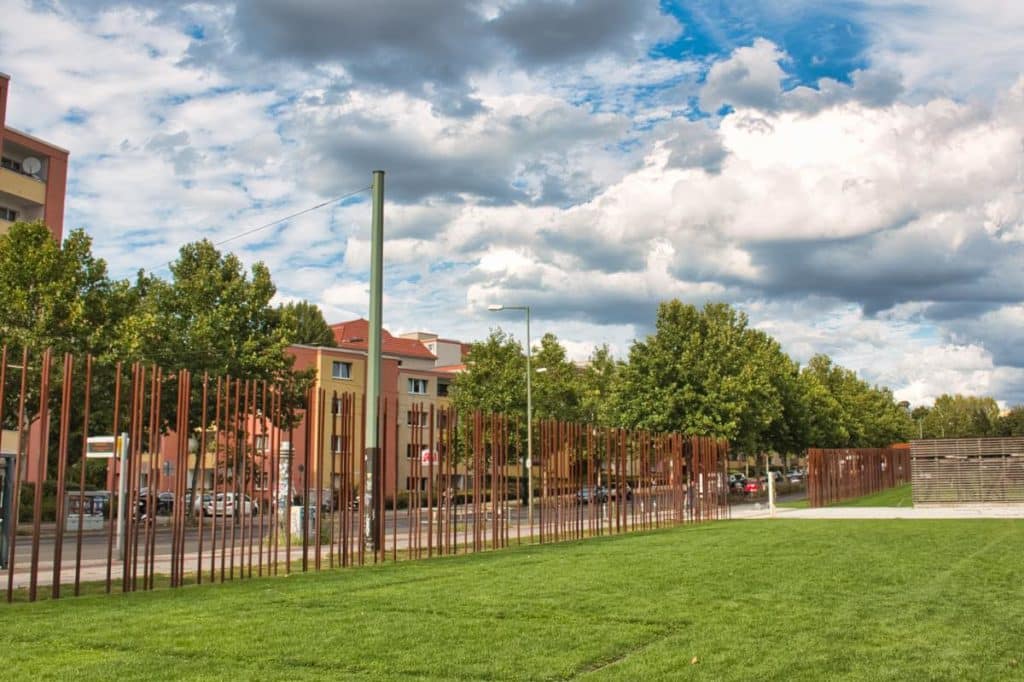
Berlin Wall Memorial
Die Berliner Mauer trennte zwischen ihrer Errichtung 1961 und ihrem Fall 1989 nicht nur die westlichBetween its erection in 1961 and its fall in 1989, the Berlin Wall not only separated the western sectors from the capital of the GDR, but also became a symbol of the Cold War and the division of Europe. Many people lost their lives in the desperate attempt to overcome it and flee the GDR. Only parts of the Wall remain today. Sometimes they serve as a huge open-air art gallery, like the East Side Gallery, but here a different approach is taken.en Sektoren von der Hauptstadt der DDR, sondern wurde zum Sinnbild des Kalten Krieges und der Teilung Europas. Viele Menschen kamen bei dem verzweifelten Versuch, sie zu überwinden und aus der DDR zu fliehen, ums Leben. Von der Mauer sind heute nur noch Teile erhalten. Mal dienen sie wie die East Side Gallery als riesige Freiluft-Kunstgalerie, hier wird aber ein anderer Ansatz gewählt.
The Berlin Wall Memorial is the central place of remembrance for the division of Germany and the deaths at the Wall. Here, the history of the Wall is told in an exemplary way and you can get an impression of the former border fortifications that are still well preserved here. Definitely one of the most impressive experiences of your Berlin visit!
Book recommendations
You want to more information about Berlin? Then maybe our book tips on the subject will help you.
- Schulte-Peevers, Andrea (Author)
Classic tour guide about the city with all the practical information you need for your Berlin trip.
- Schulte, Bennet (Author)
The bilingual book leads to the Berlin Wall sights and memorials.
No products found.
Great overview of Berlin’s history with a completely unusual approach
No products found.
A critically acclaimed biography of the Checkpoint Charlie and the division of the city
No products found.


